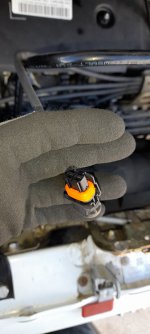- Joined
- Nov 3, 2014
- Messages
- 897
- Points
- 316
Hi
The rattle (oscillaton) will occur when you have a resonant mechanical system (i.e. a spring and a mass) and it is excited in some way, in this case by the gas pressure under certain conditions. If there is a bit of friction in the system it will tend to dampen the oscillation, which is good. Not too much friction though, or the actuator will not be able to move it properly. Any free play (maybe a little bit of wear in the spindle bush) will tend to increase oscillation. Light lubricant like WD40 may reduce the friction, which is maybe not what you want. On the other hand, if there is drag from heavy grease this will dampen the oscillation, which is useful. I am not sure if there is a type of grease which can withstand the high temperatures and still be heavy (viscous) enough to give damping in the long term.
Some people have cured the noise by fitting a small coil spring to pull the actuating lever sideways. Maybe this compensates for the play in the spindle bush, by keeping the spindle biased to one side of the bush where it will have metal-on-metal friction ?
I cannot see how the oscillation/rattle can affect the average boost by very much, unless the movement is quite large. Only a small video camera and monitor would let you see it while driving.
Thinking about other causes, your symptoms suggest something that comes and goes. This is typical of poor electrical contacts, which are sensitive to heat and vibration. Without seeing your van, I cannot suggest where to look but I agree the injectors would be a good start as they draw high peak currents so are sensitive to poor connections. This is a bit surprising, as the pictures and videos of your van show it to be very clean underneath and suggest it has been kept indoors most of its life !
The throttle pedal normally has two potentiometers with separate wires back to the ECU. The ECU compares the signals from the potentiometers, to make sure they are the same (or almost the same). If they are too different, it will store an error code but may still allow driving.
The rattle (oscillaton) will occur when you have a resonant mechanical system (i.e. a spring and a mass) and it is excited in some way, in this case by the gas pressure under certain conditions. If there is a bit of friction in the system it will tend to dampen the oscillation, which is good. Not too much friction though, or the actuator will not be able to move it properly. Any free play (maybe a little bit of wear in the spindle bush) will tend to increase oscillation. Light lubricant like WD40 may reduce the friction, which is maybe not what you want. On the other hand, if there is drag from heavy grease this will dampen the oscillation, which is useful. I am not sure if there is a type of grease which can withstand the high temperatures and still be heavy (viscous) enough to give damping in the long term.
Some people have cured the noise by fitting a small coil spring to pull the actuating lever sideways. Maybe this compensates for the play in the spindle bush, by keeping the spindle biased to one side of the bush where it will have metal-on-metal friction ?
I cannot see how the oscillation/rattle can affect the average boost by very much, unless the movement is quite large. Only a small video camera and monitor would let you see it while driving.
Thinking about other causes, your symptoms suggest something that comes and goes. This is typical of poor electrical contacts, which are sensitive to heat and vibration. Without seeing your van, I cannot suggest where to look but I agree the injectors would be a good start as they draw high peak currents so are sensitive to poor connections. This is a bit surprising, as the pictures and videos of your van show it to be very clean underneath and suggest it has been kept indoors most of its life !
The throttle pedal normally has two potentiometers with separate wires back to the ECU. The ECU compares the signals from the potentiometers, to make sure they are the same (or almost the same). If they are too different, it will store an error code but may still allow driving.



